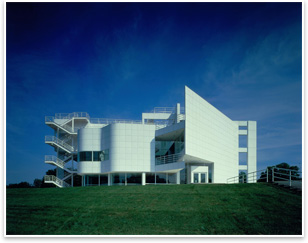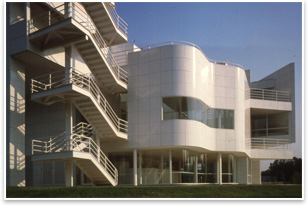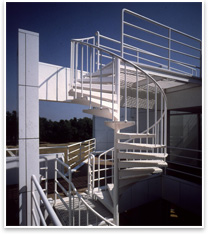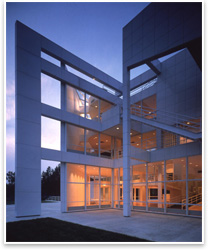|
Meier’s Atheneum Honored with Twenty-five Year Award
 Summary: The Atheneum, designed by Richard Meier, FAIA, will receive the 2008 Twenty-five Year Award. The stark white Atheneum, located on the banks of the Wabash River at the edge of New Harmony, Ind., was conceived in terms of the linked ideas of architectural promenade and the historic journey of one of America’s most significant utopian communities. Both building and architect will be honored at the American Architectural Foundation’s Accent on Architecture gala February 22, 2008, in Washington D.C. Summary: The Atheneum, designed by Richard Meier, FAIA, will receive the 2008 Twenty-five Year Award. The stark white Atheneum, located on the banks of the Wabash River at the edge of New Harmony, Ind., was conceived in terms of the linked ideas of architectural promenade and the historic journey of one of America’s most significant utopian communities. Both building and architect will be honored at the American Architectural Foundation’s Accent on Architecture gala February 22, 2008, in Washington D.C.
 The Atheneum, which serves as the visitors center for New Harmony, is the starting point for the tour of this historic town and is intended to serve as a center for visitor orientation and cultural community events. The Atheneum, which serves as the visitors center for New Harmony, is the starting point for the tour of this historic town and is intended to serve as a center for visitor orientation and cultural community events.
Enduring design
“The Antheneum is one of Richard Meier’s seminal works of architecture,” writes nominator Peter Eisenman, FAIA. “The design elements in this important work are evident throughout his career, having been further distilled to their most essential expression. While one of his earliest buildings, it is a wonderfully pure example of the recurring themes among his substantial oeuvre; it is a classic ‘Meier’ design.”
Visitors arriving by boat land on a path that leads through a field to the building. A three-story plane set at a 40-degree angle to the podium acknowledges the point of arrival. Once visitors have crossed the threshold, the entry box propels them to the foot of the internal circulation ramp.
 From here, the pedestrian circulation through the building is a continuous experience, of which the interior ramp is chief mediator and armature. The ramp winds upward from the orthogonal grid and regains the five-degree offset orientation of the path from the river; the entire building is set in motion. The geometry of overlaid grids induces a sense of spatial compression at certain points, tension at others, with grids almost colliding. This collision resonates throughout the interior of the complex of the ramp, illuminated by light from above, and resolves the two grids in plan and section. From here, the pedestrian circulation through the building is a continuous experience, of which the interior ramp is chief mediator and armature. The ramp winds upward from the orthogonal grid and regains the five-degree offset orientation of the path from the river; the entire building is set in motion. The geometry of overlaid grids induces a sense of spatial compression at certain points, tension at others, with grids almost colliding. This collision resonates throughout the interior of the complex of the ramp, illuminated by light from above, and resolves the two grids in plan and section.
On reaching the third-level exhibition space, the visitor can look back on the route traveled, through staggered interior slots and windows framing the essential spaces, as well as forward to what is to come. Framed views to the exterior allow controlled glimpses of the town and the landscape. At the uppermost roof terrace, the visitor is confronted with the town. This small space affords a panoramic vista like that from the prow of a ship. Visitors descend by way of a second ramp—this one elongated and stepped, an uncoiled version of the interior ramp—leading out of the building and into New Harmony itself.
 Harmonic design Harmonic design
“The integration of the building into the context at the edge of New Harmony provides an important gateway to the community. The circulation, bringing visitors to the exhibition space on the third floor then provides views to the town and surrounding landscape. The architectural promenade, in important contextual situations, continues to be an important issue in Richard Meier’s work today,” Eisenman writes.
Prior accolades
The Atheneum has received numerous design awards, including the Progressive Architecture Award for 1979 and an AIA Honor Award in 1982. The stunning building, which serves as the Visitors Center for New Harmony, houses exhibits on the communal history of New Harmony, a large theater where an orientation film on the town is shown, and the Museum Shop. The Atheneum’s galleries also accommodate frequent receptions and meetings, allowing the structure to continue to participate in the vitality of this still unique community.
|





